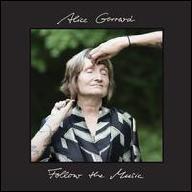Alice Gerrard was born in Seattle, Washington on July 8, 1934. Her parents both had backgrounds in classical music, and Alice learned to play the piano at a young age. However, while there were occasional family sings around the piano, Gerrard didn't hear much in the way of folk music until she attended Antioch College in Ohio. Gerrard made friends with folk music fans in her dorm, and through them heard Harry Smith's influential collection Anthology of American Folk Music. Gerrard became fascinated with the stark music and dark themes of Smith's Anthology, and she learned to play guitar.
Gerrard left Antioch without graduating and relocated to Washington, D.C., where she discovered a lively folk music community, with special enthusiasm for bluegrass and old-time music. As Gerrard became a presence on the D.C. folk music scene, she became friends with Mike Seeger of the New Lost City Ramblers (they would marry years later after the death of Gerrard's first husband). Seeger introduced Gerrard to Hazel Dickens, a West Virginia-born singer living in Baltimore, Maryland who had a passion for classic Appalachian folk songs. Dickens and Gerrard discovered they harmonized well together, and they started playing shows together, quickly developing a loyal following in Washington, D.C. and Baltimore.
In 1965, Dickens and Gerrard recorded a set of old-time classics at a church in Washington, D.C., backed by a group that included David Grisman on mandolin, Lamar Grier on banjo, and Chubby Wise and Billy Baker on fiddles. The session was released by Verve Folkways under the title Who's That Knocking? Years later, artists such as Emmylou Harris and Gillian Welch would cite it as a key influence, and Dickens and Gerrard are often acknowledged as the first female-led act in bluegrass. But a follow-up LP, Won't You Come and Sing for Me, also recorded in 1965, wasn't released until Rounder Records brought it out in 1973. Rounder would release two more albums by Dickens and Gerrard, 1973's Hazel Alice and 1976's Hazel Dickens Alice Gerrard; the duo's four albums were collected into a CD set, 1996's Pioneering Women of Bluegrass.
In 1980, Gerrard recorded an album with Mike Seeger, simply titled Alice Gerrard Mike Seeger (they had previously made a live album in 1971, and the two were reissued on one disc in 2008 as Bowling Green), but she spent most of the decade working behind the scenes. She edited a magazine called The Old-Time Herald that covered veteran artists playing bluegrass and old-time music and, in collaboration with Les Blank and Cece Conway, she directed Sprout Wings and Fly, a documentary about Appalachian fiddler Tommy Jarrell. Gerrard would also go on to teach courses on music and folklore at the University of North Carolina and Duke University.
It wasn't until 1994 that Gerrard made her belated debut as a solo artist, recording Pieces of My Heart for the respected bluegrass label Copper Creek Records. She teamed up with multi-instrumentalists Brad Leftwich and Tom Sauber, forming the trio Tom, Brad Alice, and the act cut three albums together, 1998's Been There Still, 2000's Holly Ding, and 2001's We'll Die in the Pig Pen Fighting. Gerrard's second solo effort, Calling Me Home: Songs of Love and Loss, was released in 2002, and in 2005 Tom, Brad Alice reunited for a fourth and final album, Carve That Possum.
Gerrard turned her attention to academics and live performances for several years, but returned to the recording studio to cut 2013's Bittersweet. While teaching at Duke University, Gerrard met M.C. Taylor, a student pursuing a master's degree in folklore who also happened to be a musician, writing and recording under the rubric Hiss Golden Messenger. Taylor was a fan of Gerrard's early recordings with Hazel Dickens, and offered to produce an album for her. The result was the 2014 release Follow the Music. In 2017, Gerrard and fellow old-time music advocate Kay Justice joined forces to cut the album Tear Down the Fences. ~ Mark Deming, Rovi

















